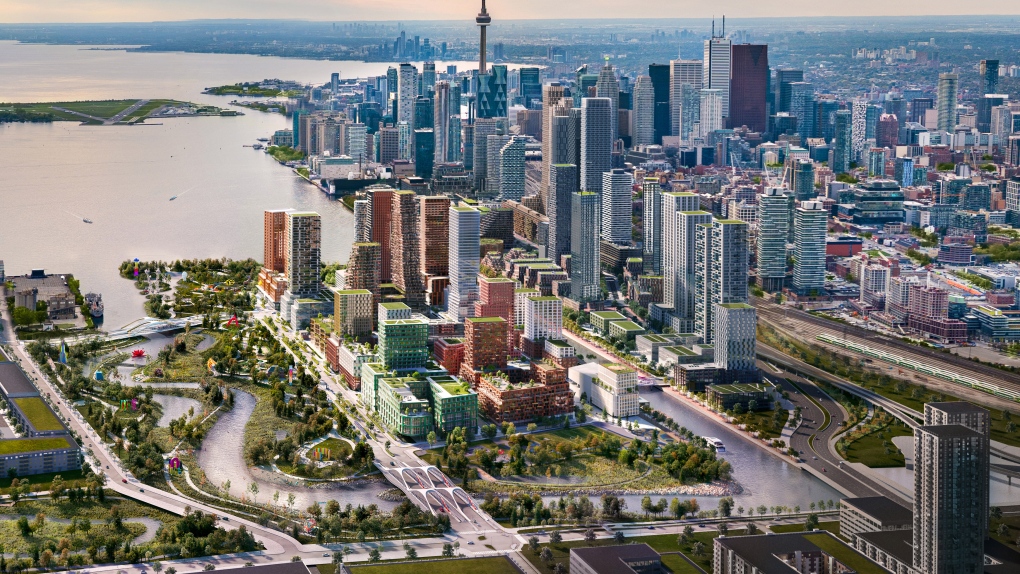Flooding raises questions about Toronto’s vulnerability to large storms
A massive rainstorm which flooded roads, basements and businesses in the city Tuesday is raising questions about Toronto’s preparedness when it comes to major weather events.
The storm, which dumped a month’s worth of rain on the city in a matter of hours, overwhelmed sewer systems and waterways, causing damage and hampering transit.
While such storms are rare, they are not unheard of. Another storm about a decade ago in 2013 caused major flooding, submerging vehicles and necessitating the rescue of passengers from a half-submerged GO Train.
With more adverse weather expected due to climate change, the city has undertaken flood mitigation work over the past decade, including a massive project to reroute the mouth of the Don River to add flood protection in the Port Lands – a project which marked a major milestone just last week and which is expected to be compete by the end of this year.
But the fact that the city has undertaken flood protection work over the past few years left some wondering why the city was then so overwhelmed by Tuesday’s storm.
Speaking on CTV Your Morning Wednesday, Mayor Olivia Chow said flood mitigation is at various stages of work in areas across the city, with some projects still waiting for dollars to flow.
“The west area, still some of those homeowners can’t even get insurance for their basements because they’ve been flooding so much,” Chow said. “So we’re waiting for the federal government to join us to really do flood mitigation measures in the west end of the city. It’s about $300 million, and they’ve said yes, it’s just we’re waiting for the funds to flow.”
Chow said the city also has “very, very aggressive” plans to build more housing in the East Harbour area, east of the Don River, but is also waiting on about $200 million from the federal government for flood protection.
However she did note that Ottawa has contributed in a “big” way to flood protection with the project to naturalize the mouth of the Don River.
One of the massive concrete “plugs” separating the newly-created stretch of river was removed last week. Once all of the plugs have been removed, the river will flow out through the new mouth, instead of emptying into the narrow Keating Channel.
 An artist’s rendering of the Port Lands in downtown Toronto following a years-long redevelopment project. (Handout /Waterfront Toronto)
An artist’s rendering of the Port Lands in downtown Toronto following a years-long redevelopment project. (Handout /Waterfront Toronto)
“The last plug about to be pulled out in the next couple of months, that will allow the Don River to flow into Lake Ontario, and that would ease a lot of the flooding,” Chow said. “So it’s happening, but we’re almost there.”
In a post, Waterfront Toronto confirmed that while a small amount of water from the Don River entered the new stretch of river, the project was not at a stage of completion that would have allowed water to flow through to the new mouth Tuesday.
“A small notch was also recently made at the west end of the North Plug to allow for construction of the riverbank where it meets the wall. Some water and debris flowed into the new river here, and the water level was a little higher than usual,” Waterfront Toronto said in its post. “Otherwise, the storm did not impact the construction site and increased waters from the Don River were still moving by way of the Keating Channel.”
However the organization also noted that the project is not meant to protect all areas that were affected by Tuesday’s flooding.
“The Port Lands Flood Protection project is designed to protect the Port Lands and portions of Leslieville and South Riverdale in a storm even bigger than yesterday’s. It is not designed to mitigate flooding on the Don Valley Parkway, which remains within the Don River flood plain.”
Speaking with CP24 Tuesday, Environment Canada Senior Climatologist Dave Phillips said that while the city might typically see one or two thunderstorms with heavy rain in a month, Tuesday brought three in quick succession and the infrastructure was not designed to cope.
“So huge amounts of rain and the system, the city infrastructure, couldn’t take it. It was overworked.
He pointed out that Toronto is “a different city” than it was about 20 or 30 years ago, with far more concrete surfaces and less green space that could absorb heavy rainfall.
Chow reiterated Wednesday that the city has been looking at ways to encourage people not to pave their properties over with nonporous surfaces.
“We want to do more. For big parking lots, if it’s just concrete, the water basically just runs off,” Chow said. “What we want them to do is have interlocking bricks, so that the water can seep into the ground, rather than just run off and flood everything else.”
Earlier this year, staff proposed a separate tax be added to utility bills as a fixed charge, depending on the size of the paved area on a property. The move led to cries that Toronto was trying to add a “rain tax.”
Chow directed staff to take another look following an outcry, but said at the time that it was important to have a plan that supports more green infrastructure, prevents flooding, and keeps water bills low.
View original article here Source









